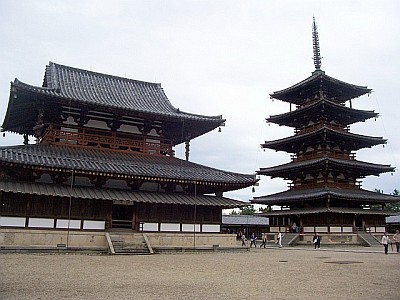
Japan
Nara, "the deer city" and Horyu-ji![[Unesco]](/images/unesco-logo.gif)
![[+]](/images/icone-etoile.png)
This is a nice outing for a day outside Kyoto... Nara was capital of Japan in the 8th century. About Horyu-ji, one can go there if interested by temples and their architecture, otherwise spending more time in Nara would be a better option.
Nara, "the deer city"
There are many things to see and I visited the park with deers, Buddhist temples, and Shinto shrines. There is much more such as the Nara national museum. It is better to get there early to have enough time for all the visits. Ask a map to the tourist information office at the exit of the station and be prepared for a good trot if you choose to go by foot... obviously it is better if sunny, but we do not always choose... As Kyoto, Nara must have pretty colors in April when the trees blossom.
Todai-ji temple

This is one of the most famous temples in Japan and just this temple could justify the trip to Nara. It was built in 752 and is classified by Unesco. This would be the
biggest wooden building in the world...
It is dedicated to the cosmic Buddha Vairocana from whom proceed all the other Buddhas. There is a 18 m (59 feet)high bronze statue of Vairocana. This statue would be
the largest bronze statue of sitting Buddha in the world...
See also a woodcarving of Pindola Bharadvaja (Binzuru in Japanese). This is one of 16 Arhats designated by the Buddha Sakyamuni at his death to keep spreading his teachings.
He is credited with occult powers. There is a belief that the one who touch a part of Pindola and then touch the same part of his body would have it cured (if hurt)...
Red clothes are offered to him in order to be protected against disease
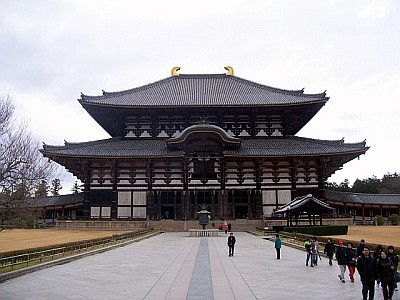
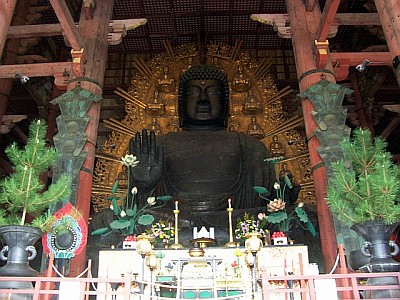
Kofuku-ji temple
The great pagoda of Nara with its 55 m (180 feet) is one of the highest in the world (the record come to the Toji temple in Kyoto). There is a Shinto shrine opposite the temple. By the way, the latter is classified by the Unesco.
A little further, there is a statue of Ksitigarbha (Jizo in Japanese) who is the bodhisattva who vowed to save people from hell. In Japan, he is also protector of travelers and children. A bib is often added to his statue to thank him for watching over children and a hat may also be added for his protection from the cold winter... This deity is also revered in Shinto. We can pour water on the statue with a ladle (presumably as an act of purification).
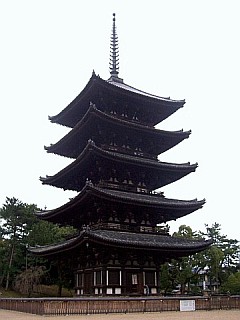
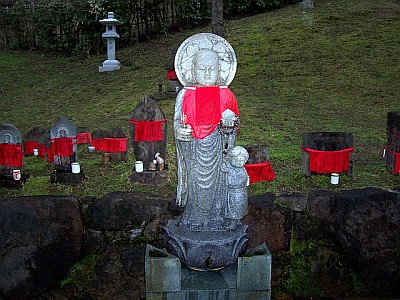
Kasuga Taisha shrine
This Shinto shrine located in the woods is the largest of Nara and is classified by Unesco. There are several stone lanterns all around the sanctuary.
Deer park
Deers are everywhere... They are fond of a variety of biscuits we can buy there... We can also visit the national museum nearby.
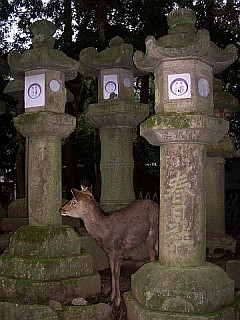
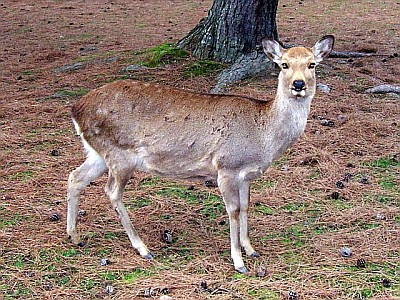
Shopping mall
After Kofuku-ji temple, by taking sanjo-dori street heading toward the station and turning on the right, there is a large shopping mall. There you can find restaurants serving okonomiyaki, a speciality of Nara (sort of pancake-omelet stuffed with seafood). The preparation and cooking is done directly in front of you.
Horyu-ji
Horyu-ji is the first Japanese site listed by Unesco. It would be the oldest wooden buildings in the world built in the early 7th century.
Inside the main hall, there are statues of Buddha and guardians who pull down demons and seem appeased. Generally the guardian deities
are represented with a look more threatening.
